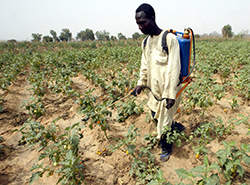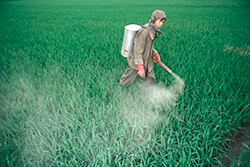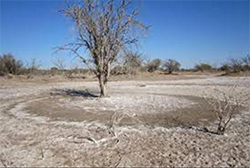Water quality
Agriculture can be a cause or victim of pollution.
Agriculture as a water polluter - Cause
 Agriculture accounts for 70 percent of total water consumption worldwide and is the single-largest contributor of non point-source pollution to surface water and groundwater. Agriculture intensification is often accompanied by increased soil erosion, salinity and sediment loads in water and by the excessive use (or misuse) of agricultural inputs (e.g. fertilizers) to increase productivity. Pollution caused by agriculture can contaminate water, food, fodder, farms, the natural environment and the atmosphere. Pesticides and fertilizers used in agriculture can contaminate both groundwater and surface water, as can organic livestock wastes, antibiotics, silage effluents, and processing wastes from plantation crops. Pollution caused by large-scale industrial farming (including livestock and fisheries) is categorized as point-source pollution,
Agriculture accounts for 70 percent of total water consumption worldwide and is the single-largest contributor of non point-source pollution to surface water and groundwater. Agriculture intensification is often accompanied by increased soil erosion, salinity and sediment loads in water and by the excessive use (or misuse) of agricultural inputs (e.g. fertilizers) to increase productivity. Pollution caused by agriculture can contaminate water, food, fodder, farms, the natural environment and the atmosphere. Pesticides and fertilizers used in agriculture can contaminate both groundwater and surface water, as can organic livestock wastes, antibiotics, silage effluents, and processing wastes from plantation crops. Pollution caused by large-scale industrial farming (including livestock and fisheries) is categorized as point-source pollution,  and pollution caused by small-scale family-sized farming is considered non-point-source pollution. One of FAO’s mandates is to work closely with countries and other UN and non-UN organizations to monitor, control and mitigate pollution loads from agricultural activities, as well as the negative impacts of agricultural pollution on people’s health and the environment. In tackling this challenge, FAO takes a multidimensional and “nexus” approach to ensure that all aspects are covered – that is, socio-economic, health, environmental and food safety.
and pollution caused by small-scale family-sized farming is considered non-point-source pollution. One of FAO’s mandates is to work closely with countries and other UN and non-UN organizations to monitor, control and mitigate pollution loads from agricultural activities, as well as the negative impacts of agricultural pollution on people’s health and the environment. In tackling this challenge, FAO takes a multidimensional and “nexus” approach to ensure that all aspects are covered – that is, socio-economic, health, environmental and food safety.
These activities are aligned with the Sustainable Development Goals (SDGs), especially SDG6.
Agriculture as a user of marginal quality water – Victim
 With increasing demand for agricultural commodities, farmers are looking increasingly at non-conventional water sources of marginal quality, including wastewater. Domestic and municipal wastewater presents an attractive option because of its high nutrient content, especially when conventional water resources are scarce or lacking.
With increasing demand for agricultural commodities, farmers are looking increasingly at non-conventional water sources of marginal quality, including wastewater. Domestic and municipal wastewater presents an attractive option because of its high nutrient content, especially when conventional water resources are scarce or lacking.
The unsafe use of non-conventional sources of water – especially wastewater – in agriculture can lead to the accumulation of microbiological and chemical pollutants in crops, livestock products and soil and water resources and ultimately to severe health impacts among exposed food consumers and farm workers; it may also exacerbate antimicrobial resistance. If adequately treated and safely applied, however, wastewater can be a valuable source of both water and nutrients and thereby contribute to food security and livelihood improvement.
 FAO’s work with countries and other organizations to deploy state-of-the-art, fit-for-purpose wastewater application technologies (e.g. fertigation) to improve farmer livelihoods and protect the environment (e.g. as an approach to climate change adaptation) is aligned with the Global Water Scarcity Initiative and SDG6.3.
FAO’s work with countries and other organizations to deploy state-of-the-art, fit-for-purpose wastewater application technologies (e.g. fertigation) to improve farmer livelihoods and protect the environment (e.g. as an approach to climate change adaptation) is aligned with the Global Water Scarcity Initiative and SDG6.3.
FAO is developing a tool for monitoring water and soil quality to be applied at the watershed level based on field data, modelling and satellite imagery. The tool will help countries monitor SDG indicators related to water quality.
